Dessert grape variety Aleshenkin adored by gardeners
The grapes on the garden plot are eye-catching - long and curly shoots, cone-shaped bunches, large and mouth-watering berries. It's impossible to walk past such a bush - you just want to eat a couple of berries. We offer a detailed description of the Aleshenkin variety. You will find out why gardeners from the southern regions of Russia love it so much and what are the secrets of a rich and stable harvest.
The content of the article
Aleshenkin grape variety
The Aleshenkin table grape variety is popular with gardeners in central Russia. It is unpretentious in maintenance, does not cause difficulties with watering and feeding. Shrubs grow on loose and nutritious soils, preferring a mixture of loamy and sandy loam lands. Growing the harvest of Aleshenkin grapes is within the power of both beginners and experienced gardeners.
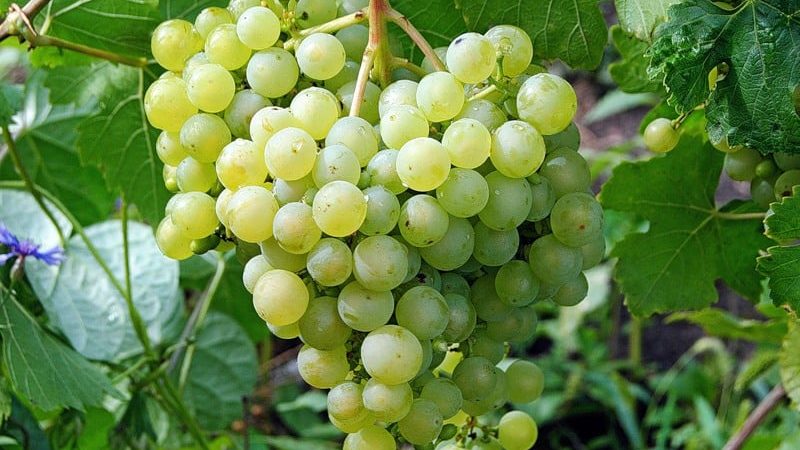
History of origin and distribution
The variety appeared in the 60s of the twentieth century thanks to the works of Russian breeders. At first, it became widespread in the south of Russia, after its marketable and taste qualities were liked by gardeners from the middle zone, and they tried to grow Aleshenkin on their lands. For 60 years this variety has been appreciated by gardeners from Novgorod, Tver, Ryazan, Belgorod regions.
Characteristics and description of the plant
The bush is tall, with powerful and long shoots and dense medium-sized leaves. The vine grows quickly, the surface is shiny and smooth, emerald green. Cuttings are distinguished by their endurance, in a short time they adapt to the place of planting and climatic conditions of cultivation. The variety is early maturing, the ripening period varies from 100 to 120 days. In the southern regions, fruits are harvested at the end of June, in the middle lane of the country, berries ripen until the end of July.
Harvest
Bunches of grapes are cone-shaped, with a pointed tip. The berries are loosely adjacent to each other, the average weight of a bunch is 1.5 kg. The berries are large, one is about 30 mm long. The shape is oval, oblong, weight - up to 5 g. Color is greenish-yellow, with amber tint and light bloom. The berries are seedless, but sometimes there are specimens with one or two seeds. The pulp is very sweet and sugary, juicy. The aroma is intense, fruity and berry.
Attention! Aleshenkin is appreciated for a stable yield. Over the summer, 20-30 kg of ripe grapes are harvested from one bush. One bush bears fruit for 15 years. In the future, it is recommended to get rid of it, since every summer the quality and taste of the berries will deteriorate. A new shrub in the old place is planted only after 4 years.
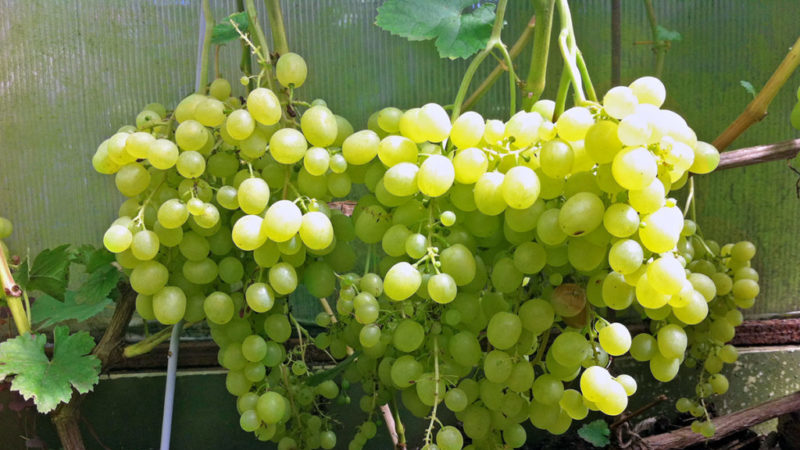
Resistance to diseases, pests, weather conditions
The variety is weakly resistant to frost, cold winds, lingering fogs. To obtain a rich harvest, it is recommended to provide it with warm and sunny conditions. For this reason, Aleshenkin grapes are not planted in the northern regions of the country.
Resistance to diseases and pests is above average. The crop is rarely affected by powdery mildew and gray mold. However, insects, fungal and viral diseases can appear at any time due to improper care or sudden changes in the weather.
Advantages and disadvantages of the variety
Of the advantages, large and beautiful berries, stable yield, early ripening are noted. The variety is appreciated for its sweet and tender pulp, immunity against common diseases and insect pests.
The disadvantage is weak resistance to sudden changes in weather, because of which Aleshenkin is not suitable for growing in the Urals and Siberia, as well as in some regions of the Far East. Some gardeners of the minuses also note the large size of the shrubs - for planting a lot of free space is required.
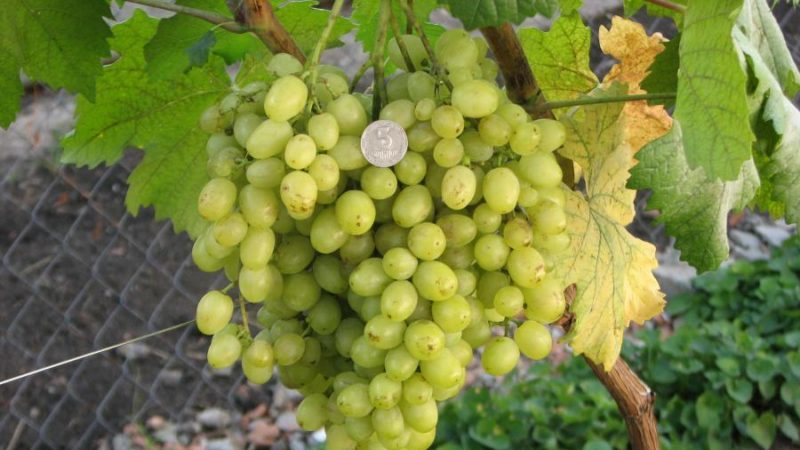
Growing technology
Like any garden culture, Aleshenkin grapes need proper planting and care. It is important to prepare the necessary tools in advance, choose the date and time.
Optimal conditions
For grapes, choose spacious and wind-protected areas. The soil should be light, with neutral acidity, otherwise the seedlings will not take root. Grapes are planted in summer or spring, depending on the region cultivation and weather conditions. It is recommended to choose a site away from groundwater and marshy areas, since an excess of moisture provokes the occurrence of diseases. Aleshenkin does not tolerate shade, so there should be no spreading fruit trees or bushes nearby.
Attention! If the soil is viscous and loamy, an additional drainage layer is created during planting. If a sandy loam mixture prevails, add compost or humus.
Terms and rules of landing
Most gardeners plant grapes in the spring - late April or early May. For 2 months, prepare a mixture of equal parts of soil, peat and humus, add 50 g of superphosphate to it. Dilute with warm water, stir in a bucket, place the cuttings in the mixture for several days. This strengthens the plant's immunity and protects young grapes from possible diseases.
Wells with a diameter of 70 cm and a depth of 80 cm are prepared on the site. 5 cm of crushed stone, 20 cm of a mixture of soil and peat are placed at the bottom, plentifully watered with hot water on top. A peg is placed in the center of the hole, a stalk with earth from a bucket is placed next to it. The hole is sprinkled with earth and carefully tamped. The first two days, the seedling is watered abundantly and the land around is mulched.
Further care
After planting, the plants are watered every 14 days - 4 liters of warm water are consumed per bush. Waterlogging will lead to rot, so it is important to monitor the amount of moisture. With frequent rains, watering is reduced. It is recommended to loosen the soil near the seedling after each watering so that a dense crust does not form on the surface.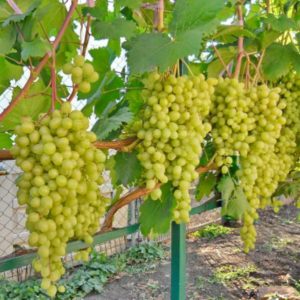
Before flowering, the plantings are fed with ash, mullein solution or superphosphate. Fertilizers promote the rapid development of ovaries and strengthen the immune system. Extreme feeding is organized at the end of June - humus or bird droppings are introduced into the ground. Timely fertilization improves the taste of future fruits and protects against pests.
It is important to keep the bushes healthy. For this, gardeners form grapes. In autumn cut off old and weak branches. When pruning, up to 16 buds are left per branch. With the arrival of spring, the 4 remaining shoots are tied to a wire. Each bush should have about 40 eyes.
Attention! Every year grapes endure more and more stress, so gardeners calculate the required number of brushes on the vine. If there are a lot of berries, they will rot due to the proximity to each other. Therefore, gardeners normalize the bush - they cut out a third of the berries with sharp scissors. The fewer fruits there are, the more nutrition everyone will receive, the juicier and tastier the harvest will be.
Possible problems, diseases, pests
If you do not weed the beds and do not clean the soil of debris, spider mites and itching appear. They destroy berries, they can ruin the entire crop. To prevent the appearance of insects, it is recommended to treat the bushes with a solution of wood ash. Spraying is carried out in the morning or in the evening so that the solution does not evaporate due to the sun.In total, 2-3 procedures are required per season.
With high humidity, diseases occur. Spots on shoots and leaves indicate the occurrence of downy mildew. The disease develops rapidly, affects young and old bushes. To fight gardeners use a solution of Bordeaux liquid or the drug "HOM".
Another disease is elementosis, the cause of which lies in the lack of mineral elements (nitrogen, potassium, phosphorus, iron). Shoots wilt, covered with yellow spots. Elementosis is treated by spraying with a solution of copper sulfate.
Attention! For preventive purposes, gardeners use Topaz or Ridomil preparations. Spend 1-2 sprays per season.
Wintering
In the middle of autumn, gardeners think about sheltering grapes for the winter. The vines are tied together and laid on the ground, sprinkled with dry soil in several places. Sometimes they are covered with burlap on top to provide additional protection. The soil is taken at a distance of 1-2 m from the base of the bush, otherwise it will freeze deeply in the area of \ u200b \ u200bthe roots. A winter shelter not only protects from frost and winds, but also prevents rodents and other pests.
Features of cultivation depending on the region
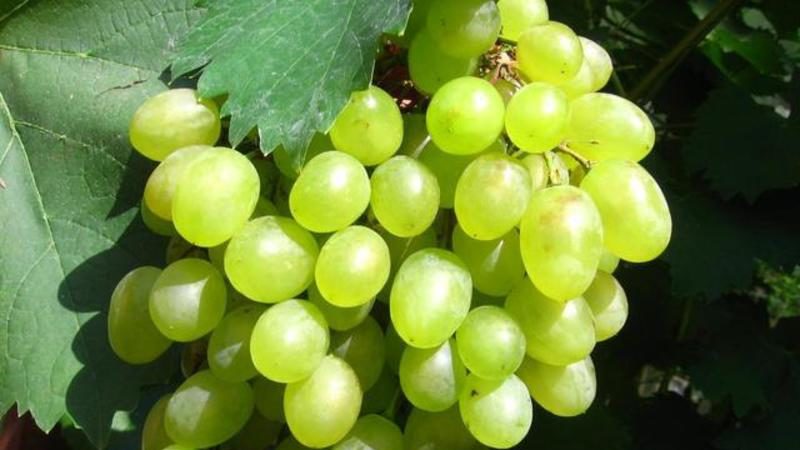
In central Russia, the Aleshenkin variety needs additional fertilizers. Gardeners use drugs "Magic Watering" or "Zdraven". Mineral complexes saturate the plant with nitrogen and phosphorus, which is important for the development of young bushes. Top dressing is added after watering, so that, together with water, minerals quickly get into the ground.
In the south, it is important to observe the irrigation regime - heat and excess water can lead to the development of fungal diseases. To maintain the health of the beds, it is recommended to remove weeds in a timely manner and mulch the plantings with sawdust, pine needles, and straw.
Attention! When the grapes have faded, they are sprayed with Strobi systemic fungicide. It destroys pathogenic microorganisms and pests.
Harvesting and application of the crop
The ripeness of berries is determined by their characteristic color and sweet aroma. The grapes are covered with a thin white bloom, the skin is translucent, the pulp becomes elastic. If the fruit is rotting, it is recommended that you throw it away immediately. Healthy berries are placed in clean wooden boxes. One part of the crop is dried for the winter, the other is processed.
Aleshenkin grapes are suitable for fresh consumption. Before eating, wash it thoroughly with cool water. They also add to ice cream and sherbet, prepare preserves, jams, juices, compotes, marmalade and jelly. Grapes are rich in vitamins and minerals and are often found in the diet of vegetarians and raw foodists. Its mild and sweet taste is combined not only with other fruits and berries, but also fish, meat, vegetable delicacies. For example, a popular salad of grapes, shrimps, herbs, sour cream sauce.
Reproduction
For propagation of grapes Aleshenkin use summer or winter cuttings. The culture is able to recover from one shoot, it retains all the characteristics of an adult plant. Propagation by cuttings is used by farmers and amateur gardeners. To do this, take the middle part of the fruit arrow. The breeding process is as follows:
- All stepchildren, leaves, shoots are removed from the branch.
- 4 buds are left on each cuttings.
- Cut off the lower part in a straight line above the lower eye.
- Tie the shoots into one bunch, place them in a bucket of warm water.
- Etched with a solution of Bordeaux liquid.
- Placed in a dense film and put into the basement.
Winegrowers reviews
Reviews of experienced gardeners will help determine the strengths and weaknesses of grapes.
Pavel, Yeysk: “Aleshenkin planted the variety 10 years ago. The bushes grew quickly, there were no problems with the cuttings. I harvest at the end of July, always happy with the result. The berries are large, amber-green, the pulp is very juicy and sweet. We love to eat grapes with the whole family. During cultivation, the bushes have never hurt. "
Ekaterina, Moscow region: “I love grapes, I decided to try the Aleshenkin variety. The yield is average, last season it harvested 15 kg. The berries are not bad to taste, the flesh is pleasant. Part of the crop was dried, part was eaten with the children. I rate the variety as firm "4".
Polina, Temryuk: “The Aleshenkin variety disappointed me - the cuttings took root badly. I followed all the recommendations, but I didn't manage to grow large berries. The bushes are weak, the fruits are small. It tastes sweet, but not enough. I think it's the wrong soil. "
Conclusion
Aleshenkin is a time-tested grape variety for the south and middle lane. To obtain a harvest, it is important to properly care for the plantings: water moderately, feed and weed in a timely manner. The grapes prefer sunny and spacious areas, loose and light soils. The fruits grow large, with sweet pulp, ripen quickly, and are universal in use. Productivity - up to 25 kg per bush. Resistance to diseases and pests is above average.